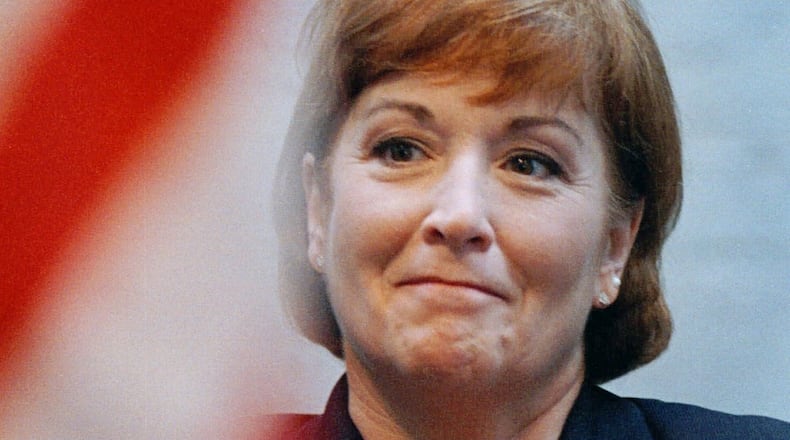Some are calling 2018 the year of the woman in politics because there are so many women on ballots across the country, including a record number running for Congress. But how many barriers women will break in Ohio this year is not entirely clear.
A couple of months ago, four women were running for governor. It’s now down to one, and could be none after the Republican primary election in May.
RELATED: Dayton Mayor Whaley drops out of governor's race As many as 16 women are running for Congress in Ohio, including the three Democrats already well entrenched in their districts. But none of the non-incumbents are considered favorites, meaning Ohio could have the same number of women in high-profile political offices as it does now.
Ohio never has had a woman U.S. Senator – and unless Republican Melissa Ackison pulls a major upset in the Republican primary, it won’t have one based on this year’s election either. She’s the only woman candidate.
Women are grossly under-represented in the halls of power in Columbus and Washington, D.C. — and always have been, according to data compiled by the Center for American Women and Politics at Rutgers University. Consider:
- Just 11 Ohio women have served in Congress, all in the U.S. House. The current makeup: 13 men and three women.
- Only 10 women have held any of the six executive statewide offices and none have been elected governor. Currently just one woman — Lt. Gov. Mary Taylor — holds one of those offices.
"There is more to Ohio than white guys and that's pretty much what we've been showing in a leadership portfolio for the past 200-some years," said Dayton Mayor Nan Whaley, who dropped out of the Democratic primary for governor and opted to back Richard Cordray.Related: Democrats Cordray, Sutton join forces in governor race
Positive step?
In an interview, Hollister said she remains optimistic that women are making strides in politics — even if her 11-day reign serves as the high-water mark for women serving as governor in Ohio.
“I don’t know that we’ve ever had so many women interested in being governor,” said Hollister, who is a current member of the state school board. “That’s a positive step in the right direction too. Of the women who were running, whatever their politics, they all had a wide variety of experience and background, which is vitally necessary. So I think we moved ever closer.”
Three of the four women candidates — Whaley, former U.S. Rep. Betty Sutton and former Ohio Rep. Connie Pillich — are Democrats and are supporting Cordray. Sutton is Cordray’s running-mate. That leaves Ohio Lt. Gov. Mary Taylor as the only woman in the race, and polls show she is trailing Attorney General Mike DeWine for the GOP nomination. She’s also well behind in fundraising.
Whaley said more needs to be done to build a bench of qualified women, particularly with executive experience such as mayor. She noted that just five of Ohio’s 30 largest cities are led by women.
Related: Cincinnati Democrat Connie Pillich leaves governor's race Warren County Commissioner Shannon Jones, a Republican former state lawmaker, said Ohio isn't alone in its undre-representation of women in power government positions .
“I don’t know that it’s distinctly Ohio,” she said. “But we clearly have a problem with mentoring and encouraging women in the highest ranks of society – whether it’s politics or the board room. We are failing at that.”
Taylor, a CPA who served in the Ohio House as well as state auditor and lieutenant governor, rarely talks about her chance to make history as the state’s first woman governor. Mostly, she is positioning herself as the most conservative candidate in the race.
Still, she recognizes that women are under-represented in Ohio politics, particularly at the top.
“When we have diverse perspectives sitting at a table talking about important issues then we’re going to get the best recommendations or best outcomes,” Taylor said.
Institutional bias?
There is one political institution in Ohio where women have achieved parity — at least for the moment. Of the seven seats on the Ohio Supreme Court, four are currently held by women. Why do women have a majority there when they hold just 19 percent of the state’s seats in Congress, 19 percent of Ohio Senate seats and 23 percent of Ohio House seats?
“I really don’t have an answer for you,” said Ohio Supreme Court Chief Justice Maureen O’Connor.“It just may be that female names are more appealing when it comes to judicial races.”
Statewide, 30 percent of Ohio’s 718 judicial seats are held by women.
Related: Kasich names Youngstown judge to Ohio Supreme Court Women may not be running for office in proportionate numbers because they lack support on the homefront or at the local party level, said O'Connor, who served as Taft's lieutenant governor. When she was first elected to the bench in 1994, O'Connor said she was a single mother who got solid support from the Summit County GOP. That was a key.
O’Connor disputes the premise that Ohio’s chances of electing a woman governor were all that bright heading into 2018, saying that declaring as a candidate is different than having a realistic shot at winning. The challenges of raising money, winning endorsements and selling a platform apply to both men and women, she said, but those with well-established names tend to have an easier time. Once Cordray and then former U.S. Rep. Dennis Kucinich entered the race for governor, the field began to thin.
Ashtabula County Republican Sandy O’Brien, who is running for state treasurer, lectured members of the Ohio GOP state central committee last month, saying there is an “institutional bias” against women candidates when it comes to fundraising and endorsements.
The party then endorsed her opponent, Robert Sprague.
Related: O'Neill's boasts of sexual liaisons brings calls for his resignation Men 'behaving badly'
In the wake of the national #MeToo movement, and the election of President Donald Trump, a surge of women have become politically active. EMILY’s List, a Democratic organization that recruits women who support abortion rights, says it was contacted by 26,000 women after Election Day 2016, more than a 26-fold increase from the two previous years.
Some believe having more women in positions of power would reduce the number of instances involving men “behaving badly.” Ohio has had a few of those episodes. In just the past year, Republican Cliff Hite resigned abruptly from the Ohio Senate after being confronted with complaints that he pestered a legislative staff member for sex; Republican Wes Goodman resigned abruptly from the Ohio House after reports that he had consensual sexual contact with a man in his state office; and shortly after lawmakers underwent mandatory sexual harassment training, dozens attended a “roast” for an outgoing staffer where crude remarks were made.
A Reuters/Ipsos Poll conducted in December 2017 found 38 percent agree that America would be better off with more women in politics, 35.6 percent say it’d be about the same and 10.1 percent say the country would be worse off.
Hollister had this advice for young women who want to make their mark in Ohio politics: start local, volunteer on campaigns, get to know the issues. Eventually, women will be elected to the top seats, she said.
“I think it’ll happen. I think it’s absolutely inevitable,” Hollister said. “I hope it’s a shorter time frame than longer but I also must say that I want women to … vote for the most qualified, capable individual. I look forward to that day and whether they’re male or female doesn’t make any difference.”
About the Author

